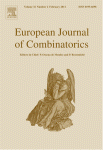European Journal of Combinatorics
The European Journal of Combinatorics is an international peer-reviewed scientific journal that specializes in combinatorics. The journal primarily publishes papers dealing with mathematical structures within combinatorics and/or establishing direct links between combinatorics and the theories of computing. The journal includes full-length research papers, short notes, and research problems on several topics.
 | |
| Discipline | Combinatorics |
|---|---|
| Language | English |
| Edited by | Patrice Ossona de Mendez, Marthe Bonamy |
| Publication details | |
| History | March 1980[1] to present |
| Publisher | |
| Frequency | 4/year (1980–1987) 6/year (1988–1995) 8/year (1996 to present) |
| Hybrid | |
| 0.847 (2020) | |
| Standard abbreviations | |
| ISO 4 | Eur. J. Comb. |
| MathSciNet | European J. Combin. |
| Indexing | |
| ISSN | 0195-6698 |
| Links | |
This journal has been founded in 1980 by Michel Deza, Michel Las Vergnas and Pierre Rosenstiehl.[2][3] The current editor-in-chief is Patrice Ossona de Mendez and the vice editor-in-chief is Marthe Bonamy.[3]
Abstracting and indexing
The journal is abstracted and indexed in
The impact factor for the European Journal of Combinatorics in 2020 was 0.847.[8]
External links
References
- "European journal of combinatorics = Journal européen de combinatoire = Europäische Zeitschrift für Kombinatorik". Cambridge University library catalogue. Retrieved 24 February 2013.
- M.D.; M.L.V.; P.R. (March 1980). "Éditorial". European Journal of Combinatorics. 1 (1): 1–3. doi:10.1016/S0195-6698(80)80013-8.
- "European Journal of Combinatorics, Editorial board". Retrieved September 13, 2023.
- "European Journal of Combinatorics". MIAR: Information Matrix for the Analysis of Journals. University of Barcelona. Retrieved September 13, 2023.
- "Web of Science Master Journal List". Intellectual Property & Science. Clarivate. Retrieved September 13, 2023.
- "Source details: European Journal of Combinatorics". Scopus Preview. Elsevier. Retrieved September 13, 2023.
- "Serials Database". ZbMATH Open. Retrieved September 13, 2023.
- 2020 Journal Citation Reports, Clarivate Analytics, 2021.
This article is issued from Wikipedia. The text is licensed under Creative Commons - Attribution - Sharealike. Additional terms may apply for the media files.